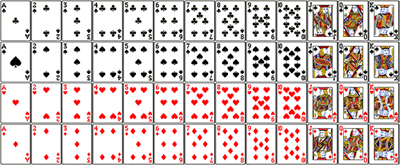Math Portal
Introductory Statistics
Section 2.6 - The Complement Rule for Probability
The complement of an event E, denoted by Ê is the event that E does not occur. The probability of the complement of an event E is given by P(Ê) = 1 - P(E).

EXAMPLE: Suppose a single card is drawn at random from a well-shuffled standard deck of 52 playing cards. What is the probability that the card is not a diamond?
SOLUTION: There are 13 diamonds in the deck, so P(diamond) = 13/52; thus, the probability that the card is not a diamond = 1 - 13/52 = 39/52 or 3/4.
EXAMPLE: Let's look at our deck of playing cards again.

And let's define event E = a card less than a King is drawn. If I ask you to find P(E), you're should not count them up. Instead, you'll say there are 52 cards all together, and there are 4 kings, so P(King) = 4/52. The probability of less than a king is 1 - 4/52 or 48/52 = 12/13.
The complement of an event E, denoted by Ê is the event that E does not occur. The probability of the complement of an event E is given by P(Ê) = 1 - P(E).

EXAMPLE: Suppose a single card is drawn at random from a well-shuffled standard deck of 52 playing cards. What is the probability that the card is not a diamond?
SOLUTION: There are 13 diamonds in the deck, so P(diamond) = 13/52; thus, the probability that the card is not a diamond = 1 - 13/52 = 39/52 or 3/4.
EXAMPLE: Let's look at our deck of playing cards again.

And let's define event E = a card less than a King is drawn. If I ask you to find P(E), you're should not count them up. Instead, you'll say there are 52 cards all together, and there are 4 kings, so P(King) = 4/52. The probability of less than a king is 1 - 4/52 or 48/52 = 12/13.